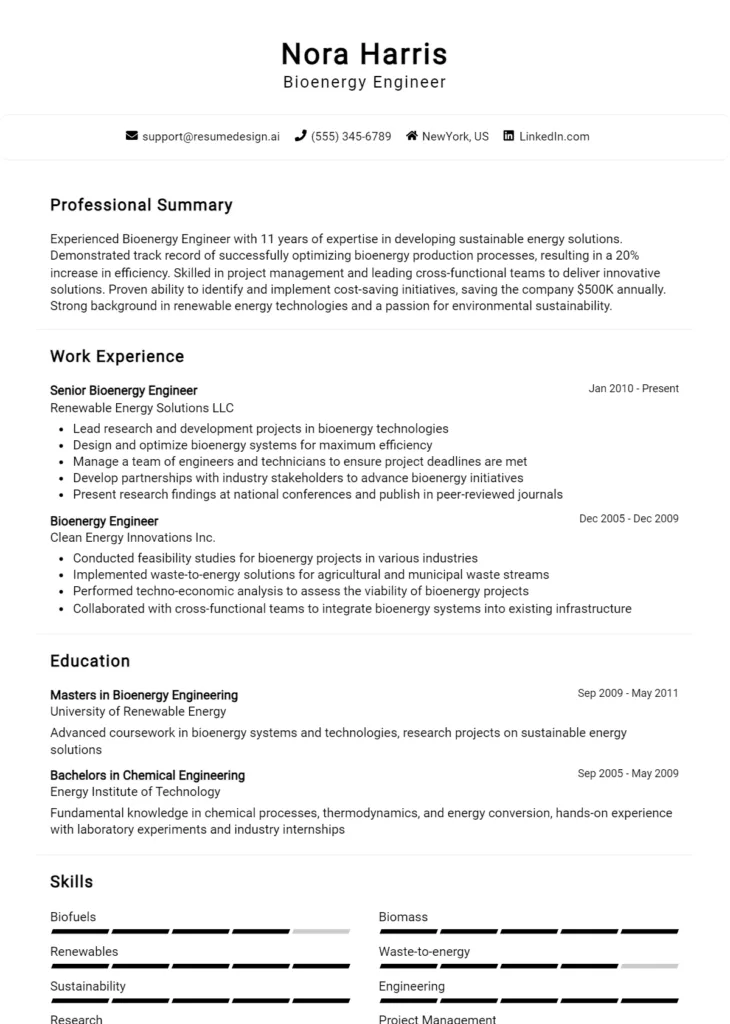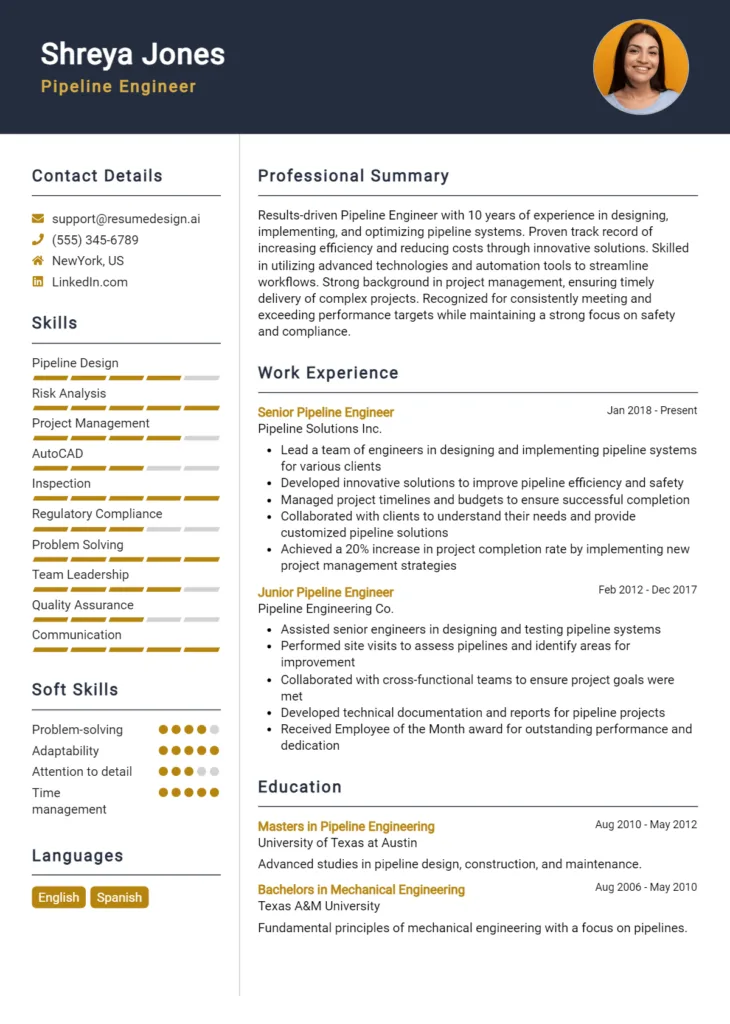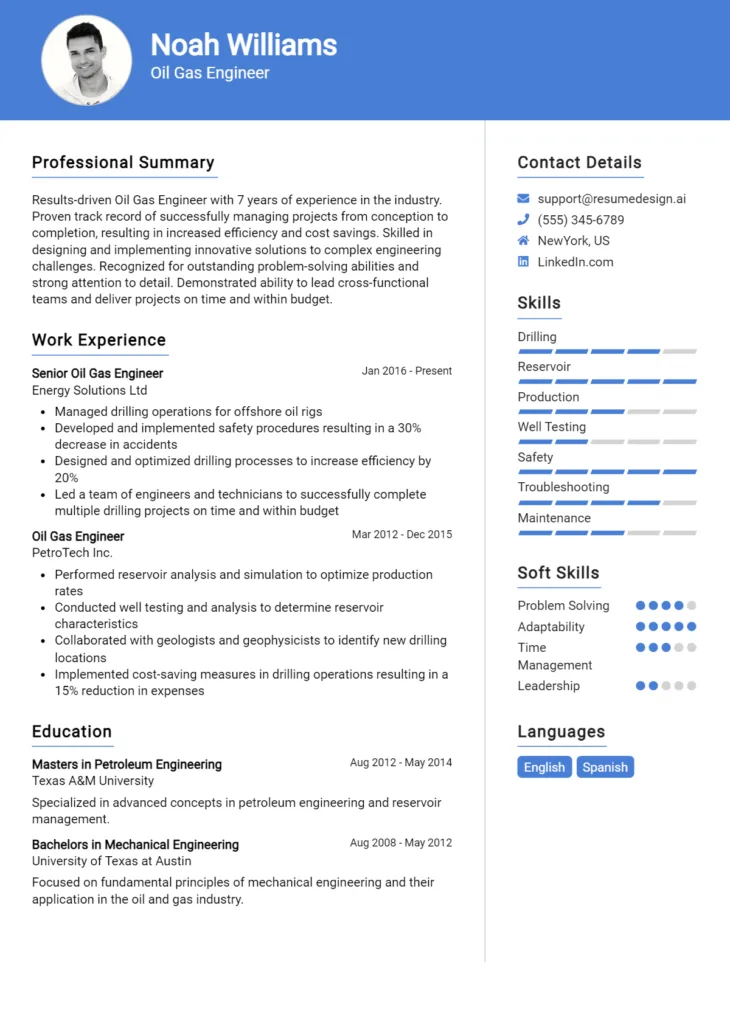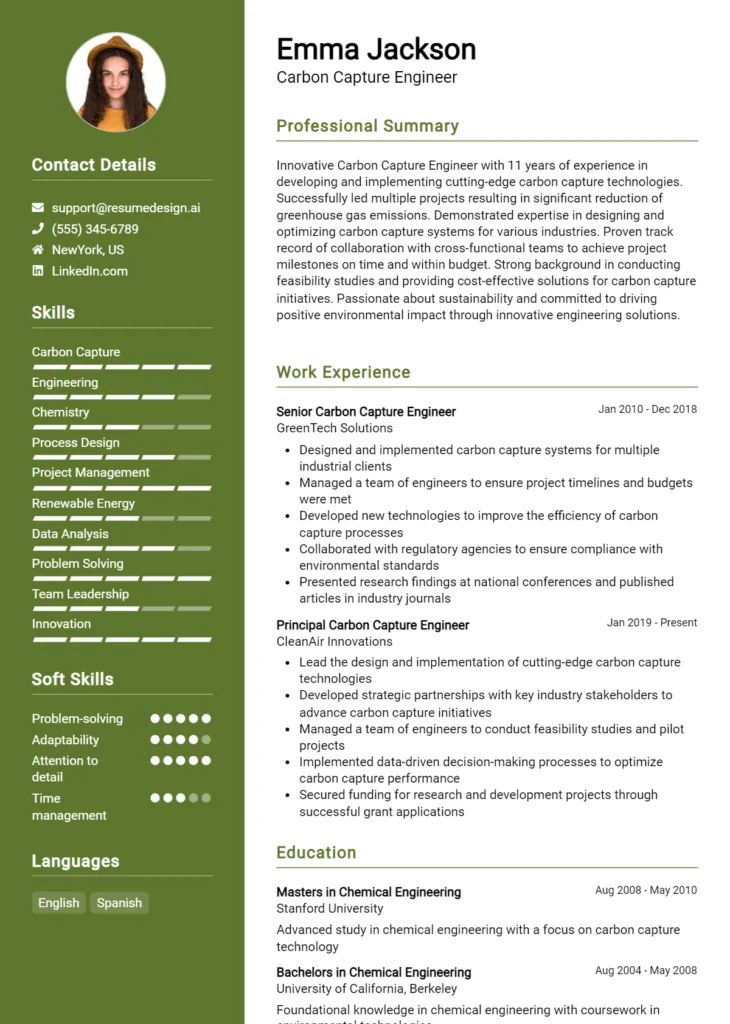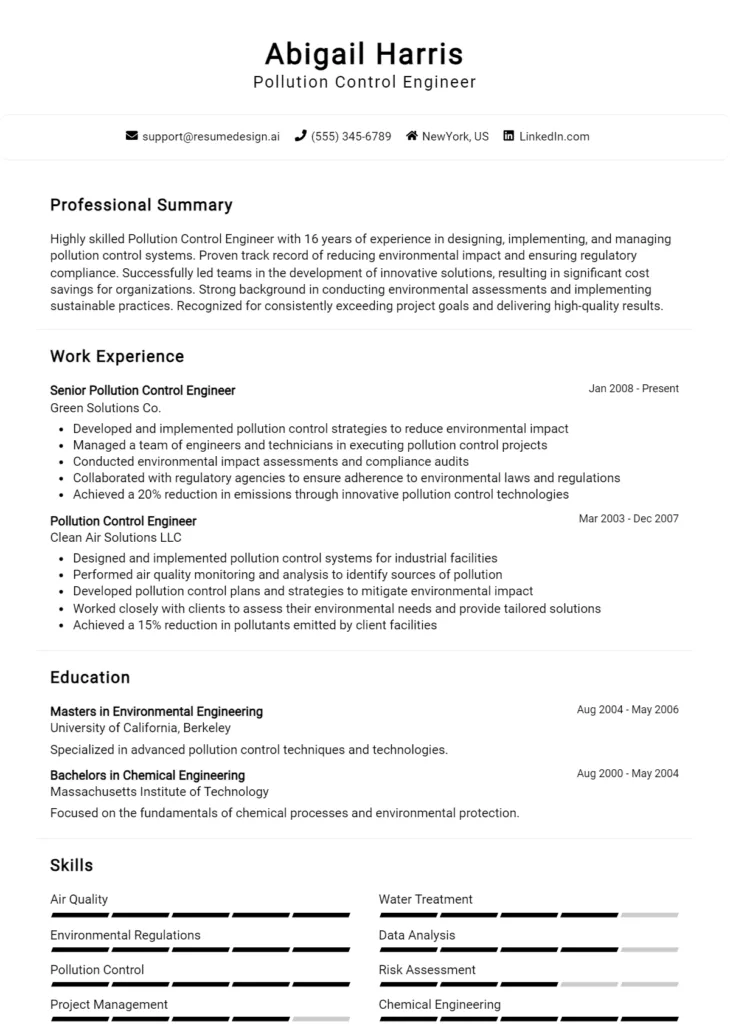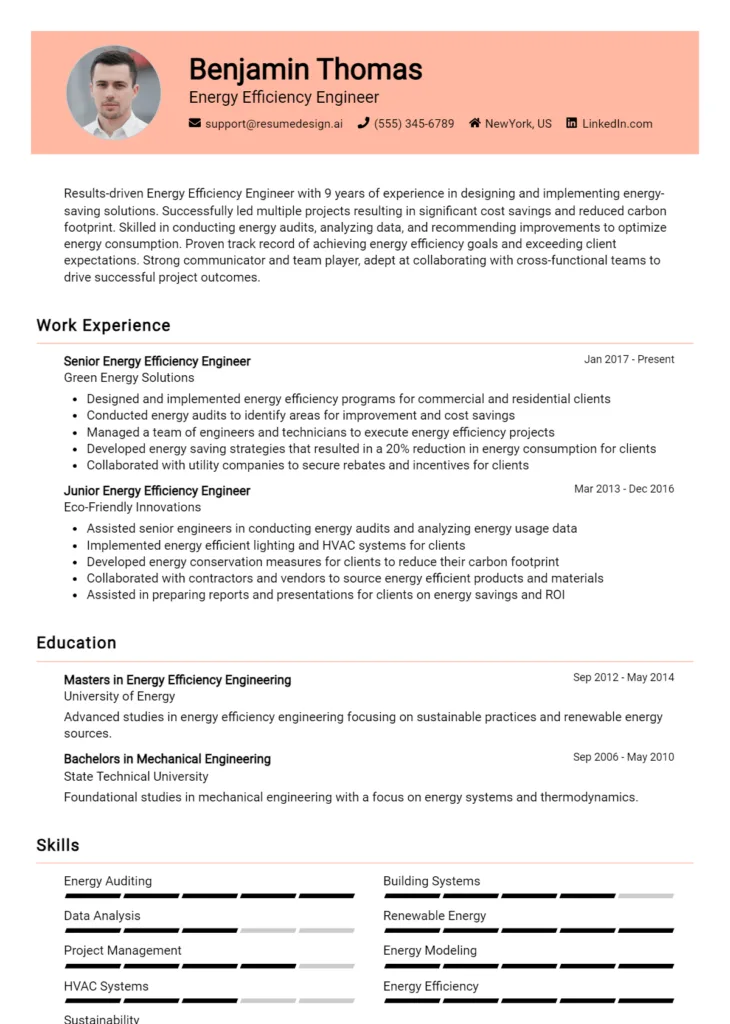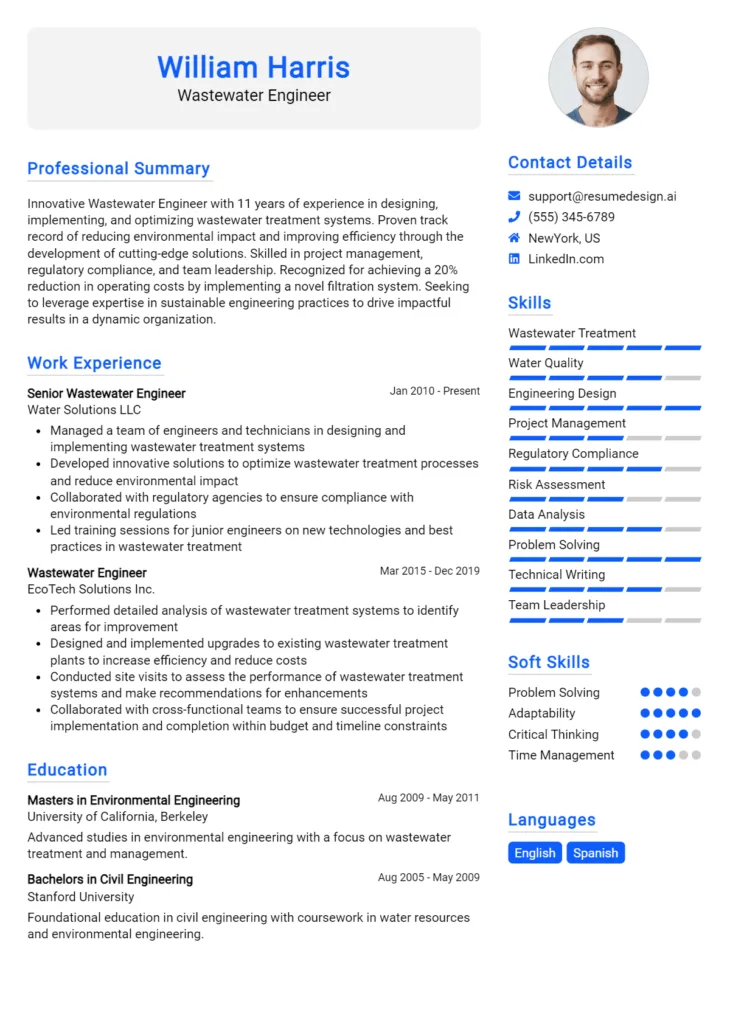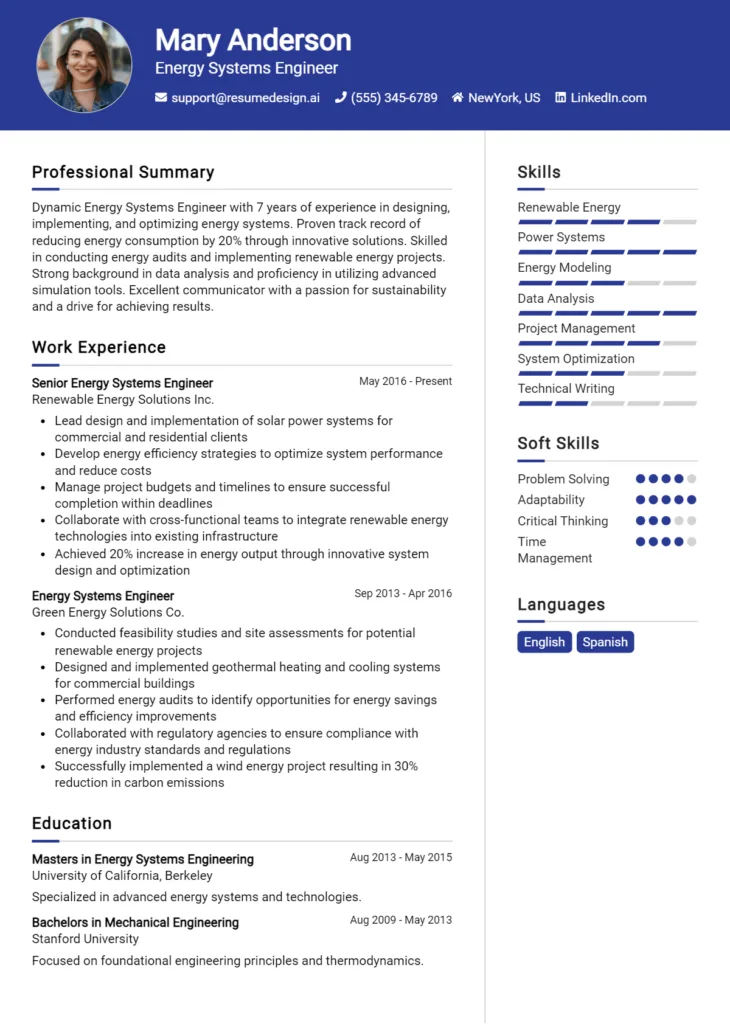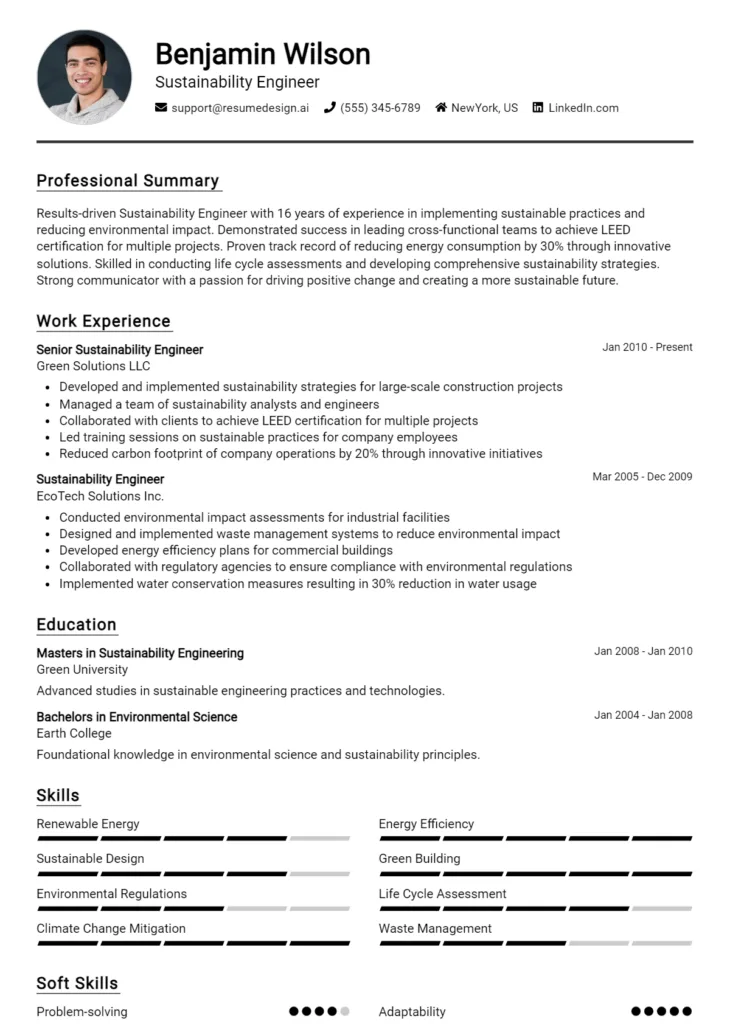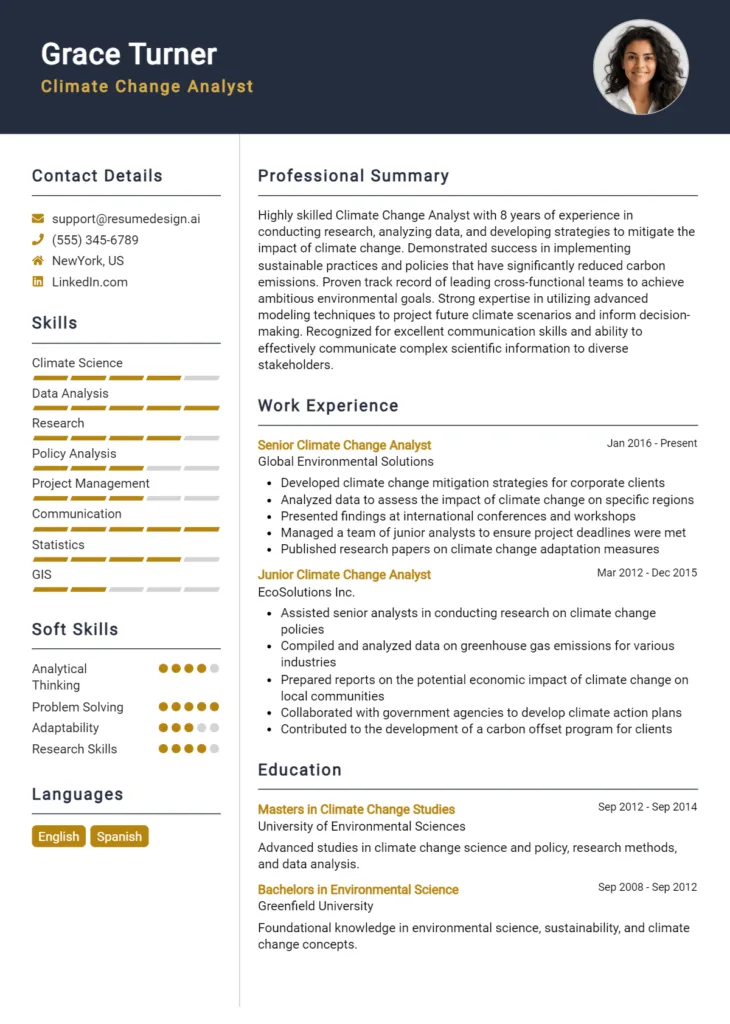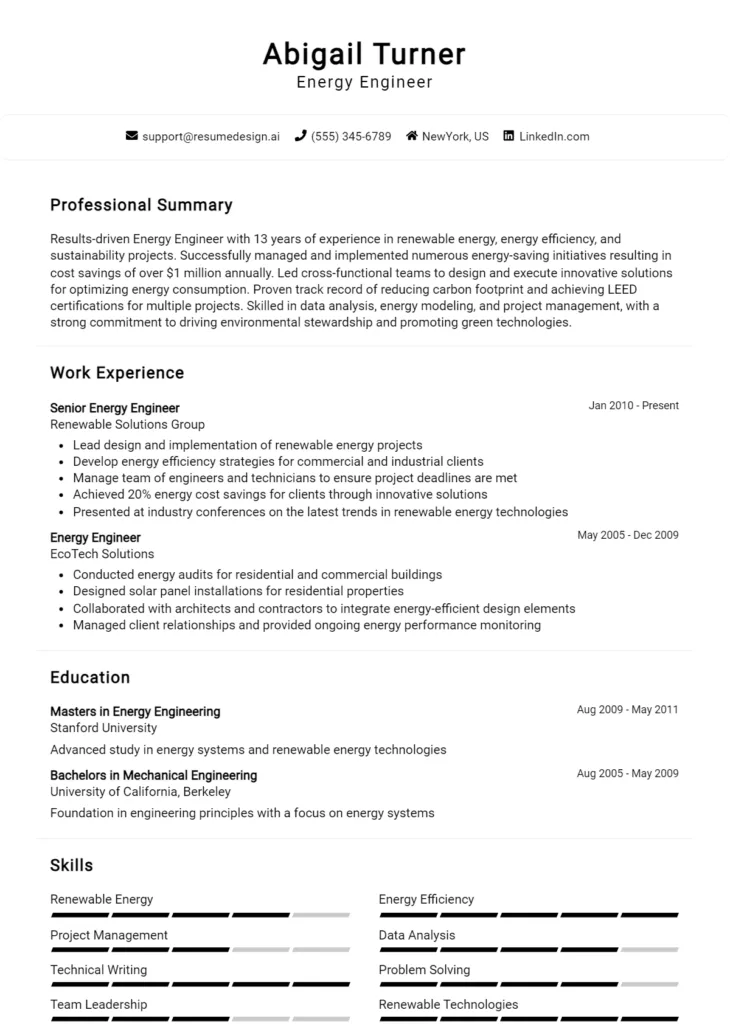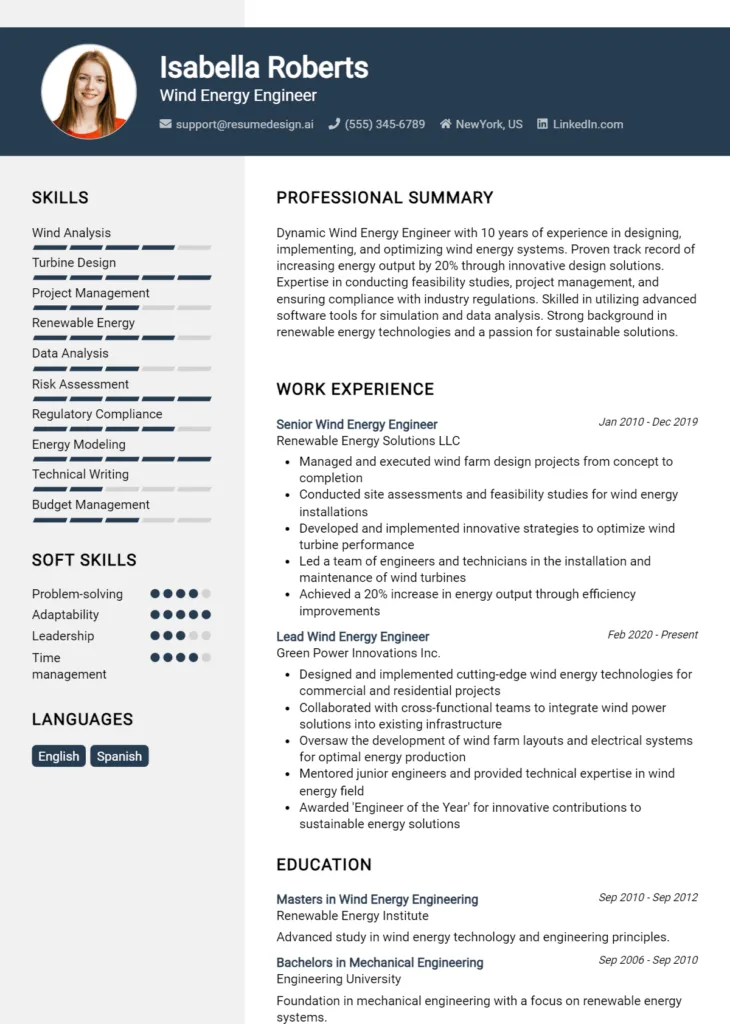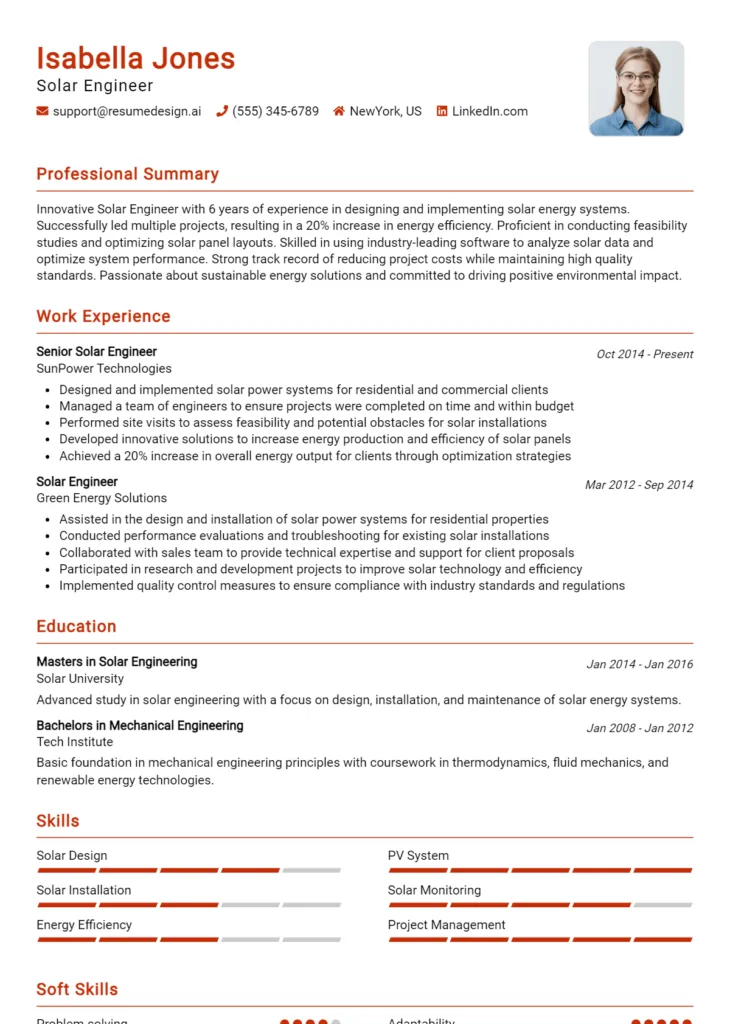Green Building Engineer Core Responsibilities
A Green Building Engineer plays a crucial role in promoting sustainable construction practices, requiring a unique blend of technical, operational, and problem-solving skills. This professional collaborates across various departments, including architecture, construction, and environmental science, to design and implement eco-friendly building solutions. Their expertise is vital in optimizing energy efficiency and resource management, ultimately contributing to the organization's sustainability goals. A well-structured resume highlighting these qualifications can effectively demonstrate their value in achieving a greener future.
Common Responsibilities Listed on Green Building Engineer Resume
- Conduct energy audits and assessments to identify efficiency improvements.
- Design and implement sustainable building systems and technologies.
- Collaborate with architects and contractors on green building projects.
- Evaluate and recommend eco-friendly materials and processes.
- Ensure compliance with environmental regulations and standards.
- Conduct life cycle assessments for building materials and systems.
- Monitor project progress and performance against sustainability goals.
- Provide training and guidance on green building practices.
- Develop strategies for waste reduction and resource conservation.
- Research and stay updated on green building technologies and trends.
- Prepare reports and presentations on sustainability metrics.
- Engage stakeholders and promote awareness of green initiatives.
High-Level Resume Tips for Green Building Engineer Professionals
In the competitive field of green building engineering, a well-crafted resume is crucial for making a lasting first impression on potential employers. As the initial representation of your skills, experience, and accomplishments, your resume needs to capture the attention of hiring managers and reflect your expertise in sustainable design and construction practices. An effective resume not only highlights your qualifications but also demonstrates your commitment to environmental responsibility—an essential trait for Green Building Engineer professionals. This guide will provide practical and actionable resume tips specifically tailored for those looking to advance their careers in this vital industry.
Top Resume Tips for Green Building Engineer Professionals
- Tailor your resume to match the job description by incorporating relevant keywords and phrases that highlight your fit for the specific role.
- Showcase your experience with sustainable building practices, LEED certification, and other green building frameworks to emphasize your expertise.
- Quantify your achievements by including specific metrics, such as the percentage of energy savings achieved in past projects or the number of sustainable buildings designed.
- Highlight industry-specific skills, such as knowledge of energy modeling software, green materials, and environmental regulations.
- Include a summary statement at the top of your resume that succinctly captures your career goals and expertise in green building engineering.
- Utilize a clean and professional format that enhances readability and emphasizes key information without overwhelming the reader.
- Incorporate any relevant certifications, such as LEED AP or BREEAM, to demonstrate your commitment to professional development in green building practices.
- Highlight collaboration and teamwork experience, as working with architects, contractors, and clients is crucial in the green building industry.
- Make sure to list any relevant continuing education courses or workshops that showcase your dedication to staying current in the field.
By implementing these tips, Green Building Engineer professionals can significantly enhance their resumes, effectively showcasing their skills and experiences. This strategic approach not only increases the likelihood of landing interviews but also positions candidates as strong contenders in a rapidly evolving and environmentally-focused job market.
Why Resume Headlines & Titles are Important for Green Building Engineer
In the competitive field of green building engineering, a well-crafted resume headline or title plays a pivotal role in capturing the attention of hiring managers. A strong headline succinctly summarizes a candidate's key qualifications and expertise in sustainable construction practices, energy efficiency, and environmental stewardship. By distilling complex information into a concise, impactful phrase, the headline serves as a powerful first impression that can set the tone for the rest of the resume. It should be relevant and directly aligned with the job being applied for, ensuring that it resonates with the employer’s needs and priorities.
Best Practices for Crafting Resume Headlines for Green Building Engineer
- Keep it concise: Aim for 10-12 words that clearly define your expertise.
- Be role-specific: Tailor the headline to match the specific position you’re applying for.
- Highlight key skills: Use industry-relevant keywords that showcase your strengths.
- Showcase credentials: Include certifications or degrees that are pertinent to green building engineering.
- Use action-oriented language: Start with strong verbs that convey your expertise and impact.
- Avoid clichés: Stay away from overused phrases that add little value.
- Align with job description: Reflect the language and requirements found in the job posting.
- Make it unique: Stand out by incorporating your personal brand or unique selling proposition.
Example Resume Headlines for Green Building Engineer
Strong Resume Headlines
Experienced Green Building Engineer Specializing in Sustainable Design and LEED Certification
Certified Green Building Professional with 10+ Years in Energy-Efficient Project Management
Innovative Green Building Engineer Driving Sustainable Solutions for Urban Development
Weak Resume Headlines
Engineer Looking for Job
Professional with Experience in Buildings
The strong headlines are effective because they are specific, informative, and tailored to the role of a Green Building Engineer, clearly articulating the candidate's relevant experience and skills. In contrast, the weak headlines lack clarity and impact, failing to convey any meaningful information about the candidate’s qualifications or unique strengths. This lack of specificity makes them forgettable and less likely to engage hiring managers, which can diminish the chances of securing an interview.
Writing an Exceptional Green Building Engineer Resume Summary
A well-crafted resume summary is essential for a Green Building Engineer as it serves as the first impression to hiring managers. This concise paragraph effectively highlights the candidate's most relevant skills, experience, and accomplishments in sustainable architecture and environmental design. A strong summary quickly captures the attention of hiring managers, providing them with a snapshot of the candidate's qualifications and demonstrating their fit for the role. By being impactful and tailored to the specific job description, the summary sets the tone for the rest of the resume and increases the likelihood of being considered for an interview.
Best Practices for Writing a Green Building Engineer Resume Summary
- Quantify achievements to demonstrate impact, such as energy savings or project costs.
- Focus on relevant skills specific to green building practices, like LEED certification or energy modeling.
- Tailor the summary to align with the specific job description, incorporating keywords from the posting.
- Keep it concise, ideally within 3-5 sentences, to maintain the hiring manager’s attention.
- Highlight unique qualifications, such as experience with specific building materials or technologies.
- Use strong action verbs to convey a sense of initiative and accomplishment.
- Emphasize collaborative skills if applicable, as green building projects often involve teamwork.
- Showcase any awards or recognitions received in the field to establish credibility.
Example Green Building Engineer Resume Summaries
Strong Resume Summaries
Results-driven Green Building Engineer with over 8 years of experience in designing and implementing sustainable building projects, achieving a 30% reduction in energy consumption across multiple residential developments. Proficient in LEED certification processes and energy modeling software, committed to enhancing environmental performance while reducing costs.
Certified Green Building Engineer with a track record of leading projects that consistently meet LEED Gold standards. Successfully managed a $5 million commercial renovation project that incorporated renewable energy solutions, resulting in a 40% decrease in operational energy costs.
Innovative Green Building Engineer specializing in sustainable materials and construction practices. Played a key role in a high-profile project that earned the AIA Sustainability Award, contributing to a 25% increase in waste diversion rates through advanced recycling techniques.
Weak Resume Summaries
Experienced engineer looking to work in green building. I have some skills related to energy efficiency.
Green Building Engineer with a general interest in sustainability and projects. I have worked on various tasks but have no specific achievements to highlight.
The strong resume summaries are considered effective because they are specific, quantifiable, and directly relevant to the role of a Green Building Engineer. They clearly articulate the candidate's achievements and skills, providing concrete examples of their impact in the field. In contrast, the weak summaries lack detail, fail to quantify outcomes, and do not convey a clear understanding of the candidate's qualifications or contributions, making them less appealing to hiring managers.
Work Experience Section for Green Building Engineer Resume
The work experience section of a Green Building Engineer resume is crucial as it serves as a platform to demonstrate the candidate's technical skills, ability to manage teams, and commitment to delivering high-quality products. This section not only highlights relevant professional experiences but also allows candidates to quantify their achievements, showing how they have positively impacted previous projects. Aligning this experience with industry standards is essential, as it assures potential employers of the candidate's capability to meet the demands of green building practices and innovations.
Best Practices for Green Building Engineer Work Experience
- Highlight specific green building certifications and methodologies employed in past projects.
- Quantify achievements with metrics, such as energy savings, reduced waste, or cost savings.
- Showcase leadership roles and teamwork experiences, emphasizing collaboration with multidisciplinary teams.
- Detail the technologies and software used in project management and design processes.
- Include project scopes, budgets, and timelines to illustrate project management skills.
- Mention any awards or recognition received for excellence in green building initiatives.
- Tailor the experience descriptions to align with current industry standards and trends.
- Use action verbs to convey a sense of initiative and accomplishment in each role.
Example Work Experiences for Green Building Engineer
Strong Experiences
- Led a cross-functional team to design and implement a LEED-certified commercial building project, achieving a 30% reduction in energy consumption compared to traditional designs.
- Managed a $1.5 million budget for a sustainable housing development, resulting in a 25% decrease in construction waste through innovative materials sourcing.
- Coordinated with architects and contractors to integrate renewable energy systems into residential buildings, increasing overall efficiency by 40%.
- Developed and executed a green building training program for staff, which improved project team performance ratings by 20% within six months.
Weak Experiences
- Worked on various projects related to green building.
- Assisted with some tasks in the design phase of a construction project.
- Involved in team meetings about sustainability initiatives.
- Helped with the implementation of energy-saving practices.
The examples provided illustrate the distinction between strong and weak experiences in a Green Building Engineer's resume. Strong experiences are characterized by clear, quantifiable outcomes that demonstrate leadership and collaboration in significant projects. They employ specific metrics to highlight achievements and use action-oriented language, providing potential employers with a robust view of the candidate's capabilities. In contrast, weak experiences tend to be vague and lack specific details, failing to convey the candidate's contributions or the impact of their work, making it difficult for employers to assess their qualifications effectively.
Education and Certifications Section for Green Building Engineer Resume
The education and certifications section of a Green Building Engineer resume is crucial for showcasing a candidate's academic background, industry-relevant certifications, and commitment to continuous learning. This section not only demonstrates the foundational knowledge required for the role but also highlights specialized training and coursework that align with the principles of sustainable design and construction. By providing relevant educational qualifications and certifications, candidates can significantly enhance their credibility and showcase their alignment with the job requirements, making them more attractive to potential employers.
Best Practices for Green Building Engineer Education and Certifications
- Include degrees related to environmental engineering, architecture, or sustainable design.
- Highlight industry-recognized certifications such as LEED Accredited Professional (AP) or Green Building Certification Institute (GBCI).
- List relevant coursework that pertains to green building practices, energy efficiency, or sustainable materials.
- Update the section regularly to include new certifications or training that reflect the latest industry standards.
- Be specific about the level of each certification (e.g., LEED Green Associate vs. LEED AP).
- Incorporate any specialized training in renewable energy systems, energy modeling, or sustainable construction techniques.
- Use concise descriptions that emphasize how the education and certifications relate to the role of a Green Building Engineer.
- Organize information chronologically or by relevance to make it easy for employers to assess qualifications.
Example Education and Certifications for Green Building Engineer
Strong Examples
- M.S. in Environmental Engineering, University of California, Berkeley (2022)
- LEED Accredited Professional (LEED AP), U.S. Green Building Council (2023)
- Certification in Sustainable Design and Construction, Green Building Certification Institute (2021)
- B.S. in Civil Engineering with a focus on Sustainable Infrastructure, Stanford University (2020)
Weak Examples
- B.A. in History, University of Michigan (1995)
- Certification in Basic AutoCAD, Local Community College (2010)
- General Construction Safety Training, Non-specific Provider (2015)
- Diploma in Landscape Architecture, Online Course (2018)
The strong examples are considered effective because they directly align with the qualifications needed for a Green Building Engineer, showcasing advanced degrees, relevant certifications, and specialized training that demonstrate a commitment to sustainable practices. In contrast, the weak examples highlight irrelevant or outdated qualifications that do not pertain to green building or sustainability, ultimately failing to support the candidate's suitability for the role.
Top Skills & Keywords for Green Building Engineer Resume
As the demand for sustainable construction practices continues to rise, the role of a Green Building Engineer becomes increasingly vital. A well-crafted resume highlighting the right skills can significantly enhance a candidate's visibility to potential employers. In this competitive field, showcasing both hard and soft skills is essential. Hard skills demonstrate a candidate's technical expertise in green technologies and building practices, while soft skills reflect their ability to communicate, collaborate, and solve problems effectively. Together, these skills create a comprehensive picture of a professional who is not only knowledgeable but also capable of driving sustainable initiatives within the construction industry.
Top Hard & Soft Skills for Green Building Engineer
Hard Skills
- Knowledge of sustainable building materials
- Proficiency in energy modeling software (e.g., EnergyPlus, eQUEST)
- Familiarity with LEED certification processes
- Understanding of building codes and regulations
- Expertise in HVAC systems and energy efficiency
- Ability to conduct life cycle assessments
- Proficiency in AutoCAD and other design software
- Experience with renewable energy systems (solar, wind)
- Skills in water conservation techniques
- Knowledge of indoor environmental quality standards
- Familiarity with green building rating systems (BREEAM, NABERS)
- Ability to perform environmental impact assessments
- Proficiency in project management software
- Understanding of acoustic design principles
Soft Skills
- Strong communication and interpersonal skills
- Excellent problem-solving abilities
- Team collaboration and leadership
- Adaptability and flexibility
- Attention to detail
- Critical thinking and analytical skills
- Project management and organizational skills
- Creativity and innovation in design
- Time management and prioritization
- Conflict resolution skills
- Client relationship management
- Strong work ethic and professionalism
- Emotional intelligence and empathy
- Ability to work under pressure
- Negotiation and persuasion skills
For further insights on how to effectively incorporate these skills into your resume, along with showcasing your work experience, consider the importance of aligning them with the job requirements to stand out in the field of green building engineering.
Stand Out with a Winning Green Building Engineer Cover Letter
Dear [Hiring Manager's Name],
I am excited to apply for the Green Building Engineer position at [Company Name] as advertised on [Job Board/Company Website]. With a robust background in sustainable architecture and a passion for environmentally responsible design, I am confident in my ability to contribute to your team's mission of creating innovative, energy-efficient buildings that meet the highest standards of sustainability. My experience in utilizing LEED standards and implementing energy modeling software has equipped me with the skills necessary to advance your projects and ensure compliance with industry regulations.
In my previous role at [Previous Company Name], I successfully led a team in the design and implementation of a green building initiative that resulted in a 30% reduction in energy consumption and earned Gold LEED certification. This project not only showcased my technical expertise in sustainable systems but also highlighted my ability to collaborate with architects, contractors, and clients to achieve shared goals. I have a proven track record of conducting thorough site assessments, performing life cycle analyses, and recommending sustainable materials and technologies that align with both budgetary constraints and environmental objectives.
I am particularly drawn to [Company Name] because of your commitment to innovation in green building practices and your focus on community impact. I admire your recent project, [Specific Project Name], which exemplifies the integration of cutting-edge design with sustainable practices. I am eager to bring my skills in energy efficiency, renewable resources, and sustainable site development to your esteemed team, and I believe that my passion for green building aligns perfectly with your company’s values.
Thank you for considering my application. I am looking forward to the opportunity to discuss how my background, skills, and enthusiasms for green building can contribute to the exciting projects at [Company Name]. Please feel free to contact me at your convenience to schedule a conversation. I am eager to explore how we can work together to create a more sustainable future.
Sincerely,
[Your Name]
[Your Phone Number]
[Your Email Address]
Common Mistakes to Avoid in a Green Building Engineer Resume
When crafting a resume for a Green Building Engineer position, it's essential to highlight relevant skills and experiences while avoiding common pitfalls that can detract from your qualifications. A well-structured resume should effectively convey your expertise in sustainable design, energy efficiency, and environmental stewardship. However, many candidates make mistakes that can undermine their chances of landing an interview. Here are some common mistakes to avoid:
Lack of Specificity: Failing to provide specific examples of projects you've worked on or technologies you've employed can make your resume vague. Include quantifiable outcomes and your role in each project.
Ignoring Industry Keywords: Not incorporating relevant keywords from the job description can result in your resume being overlooked by applicant tracking systems. Familiarize yourself with terms like LEED, energy modeling, and sustainable materials.
Overloading with Technical Jargon: While it's important to demonstrate your technical knowledge, using too much jargon can alienate hiring managers who may not have a technical background. Aim for clear and concise language.
Neglecting Soft Skills: Focusing solely on technical skills can give an incomplete picture of your abilities. Include soft skills like communication, teamwork, and problem-solving, which are crucial in collaborative green building projects.
Formatting Issues: Poor formatting can make your resume difficult to read and unprofessional. Use a clean layout with clear headings, bullet points, and consistent font styles to enhance readability.
Outdated Information: Including outdated certifications or irrelevant work experience can signal that you are not keeping up with industry standards. Regularly update your resume to reflect your most current qualifications.
Failing to Tailor Your Resume: Sending out a generic resume without customizing it for the specific job can be detrimental. Take the time to align your experiences and skills with the job description to show your fit for the position.
Omitting Continuing Education: Green building practices are constantly evolving. Not mentioning any ongoing education, certifications, or workshops can suggest a lack of commitment to staying updated in the field.
Conclusion
As a Green Building Engineer, you play a crucial role in designing and implementing sustainable building practices that minimize environmental impact while maximizing energy efficiency. Throughout the article, we discussed the importance of understanding green building standards, such as LEED certification, and the necessity of staying updated with advancements in eco-friendly materials and technologies. Your responsibilities also include collaborating with architects and contractors to ensure that projects meet sustainability goals and adhere to local regulations.
To excel in this dynamic field, it’s essential to present your qualifications effectively. A well-crafted resume can set you apart from the competition and highlight your skills and experience in green building practices. As you reflect on the insights shared in this article, take a moment to review your Green Building Engineer resume and ensure it showcases your expertise in sustainable design, project management, and regulatory compliance.
To assist you in this process, consider utilizing available resources like resume templates, which can provide a professional layout; the resume builder, an intuitive tool to create your resume step-by-step; resume examples tailored for the green building sector; and cover letter templates that complement your resume and help convey your passion for sustainability. Empower yourself to make a lasting impression in your job search by taking advantage of these valuable tools today!



